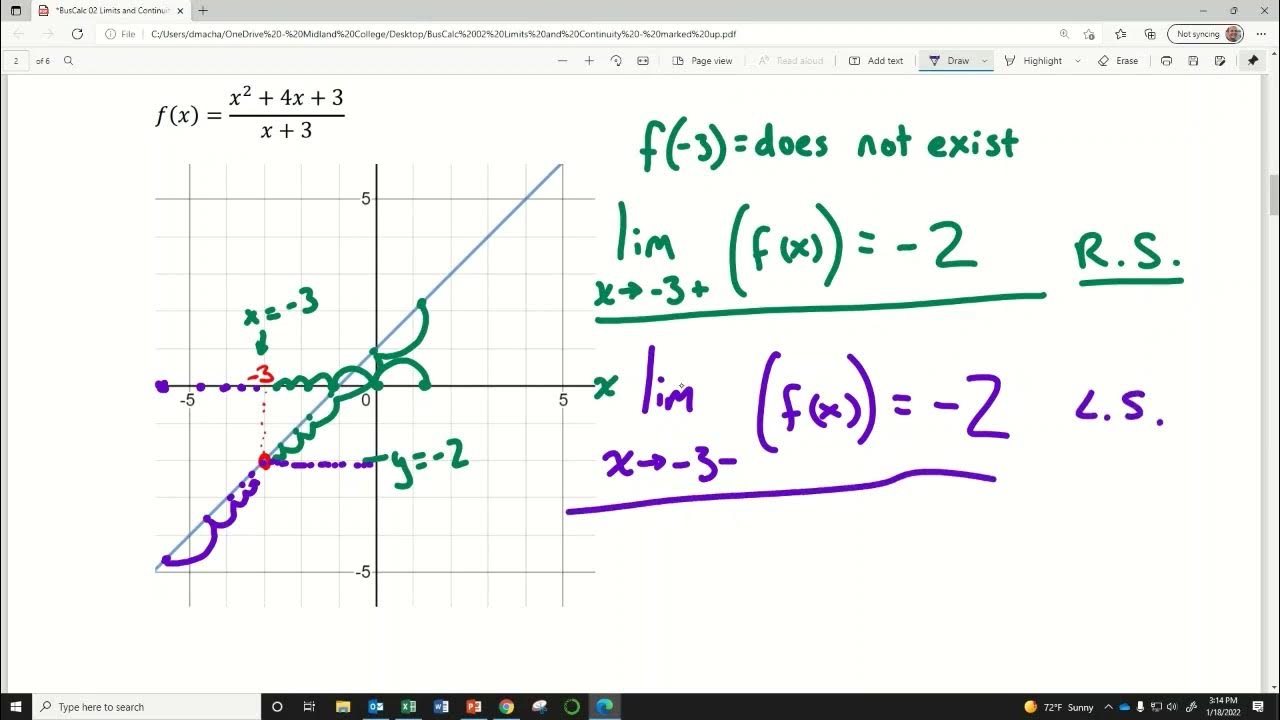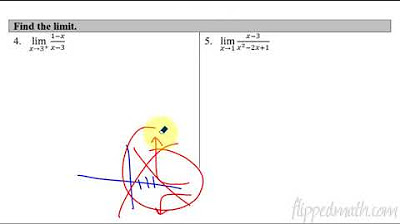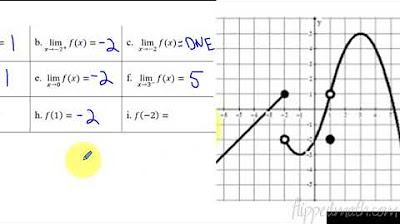How To Tell If The Limit Exists
TLDRThe video script explains the concept of limits in calculus, demonstrating how to determine if a limit exists as a value approaches a specific point. It illustrates this through examples, showing that if the left-sided and right-sided limits match, the limit exists; if not, it does not. The script also covers limits involving piecewise functions, emphasizing the importance of evaluating both one-sided limits to ascertain the existence of a limit. This foundational topic is essential for understanding more advanced calculus concepts like derivatives and integration.
Takeaways
- 🔍 To determine if a limit exists, check both the left-sided limit (as x approaches the value from the left) and the right-sided limit (as x approaches the value from the right).
- 🌟 A limit exists if and only if the left-sided and right-sided limits are equal.
- 📉 If the left-sided limit has a different value than the right-sided limit, the limit does not exist.
- 📊 The process of finding a limit involves evaluating the function at the given point from both the left and the right and comparing the results.
- 🤔 For piecewise functions, the limit at a specific point depends on which piece of the function applies to the approach from the left and from the right.
- 📚 When approaching a point from the left, use the expression of the function that applies to values less than that point.
- 📝 When approaching a point from the right, use the expression of the function that applies to values greater than that point.
- 🔗 For the limit as x approaches negative two in a piecewise function, the left-sided limit uses the expression for values less than or equal to negative two, while the right-sided limit uses the expression for values greater than negative two but less than three.
- 📈 In the case of the limit as x approaches three for a piecewise function, the left-sided limit uses the expression for values between negative two and three, and the right-sided limit uses the expression for values greater than or equal to three.
- 🏁 The limit of a piecewise function at a point is determined by the continuity and agreement of the left-sided and right-sided limits.
- 📚 For further study on limits, derivatives, and integration, additional resources such as example problems and calculus playlists are available on the provided website.
Q & A
How can you determine if a limit exists for a function as x approaches a certain value?
-To determine if a limit exists, you need to check both the left-sided limit (as x approaches the value from the left) and the right-sided limit (as x approaches the value from the right). If these two one-sided limits are equal, then the limit exists; if they have different values, the limit does not exist.
What is the left-sided limit for a function as x approaches -3, and what does it represent?
-The left-sided limit as x approaches -3 is found by looking at the y-value of the function when x is just less than -3. It represents the value that the function approaches from the left side as x gets closer to -3.
What happens when the left-sided limit and the right-sided limit of a function at a point do not match?
-If the left-sided limit and the right-sided limit of a function at a point do not match, it indicates that the limit does not exist at that point. This means the function does not have a consistent value as x approaches that point from either side.
In the example given, why does the limit as x approaches -1 exist?
-The limit as x approaches -1 exists because both the left-sided limit (approaching -1 from the left) and the right-sided limit (approaching -1 from the right) have the same y-value, which is -1. This consistency confirms the existence of the limit.
What does it mean for the limit as x approaches 3 from the left to go towards negative infinity?
-When the limit as x approaches 3 from the left goes towards negative infinity, it means that the function's y-values decrease without bound as x gets closer to 3 from the left side. This behavior indicates that the limit does not exist at x=3 from the left.
How does a piecewise function affect the evaluation of limits?
-A piecewise function can have different expressions for different intervals of x-values. To evaluate a limit for a piecewise function, you must determine which part of the function applies based on the direction from which x approaches the point of interest and then evaluate the limit accordingly.
Why does the limit not exist as x approaches -2 for the given piecewise function?
-The limit does not exist as x approaches -2 for the given piecewise function because the left-sided limit (using the expression 5x + 1) and the right-sided limit (using the expression x^2 + 1) yield different values. Since they do not match, the limit is not consistent and therefore does not exist at x = -2.
How can you confirm the existence of a limit for a piecewise function as x approaches 3?
-To confirm the existence of a limit for a piecewise function as x approaches 3, you must evaluate the expressions corresponding to the intervals just before and after 3. If the left-sided limit (using the expression x^2 + 1) and the right-sided limit (using the expression 2x + 4) yield the same value, then the limit exists and is equal to that common value.
What is the significance of checking one-sided limits for understanding the behavior of a function?
-Checking one-sided limits is crucial for understanding the behavior of a function near certain points, especially when the function is not defined at those points or when it changes its behavior abruptly. It helps to determine the stability and consistency of the function's values as it approaches specific x-values.
How can you use the process of finding limits to prepare for more advanced topics in calculus?
-Understanding the process of finding limits provides a foundation for more advanced calculus topics such as derivatives and integration. Limits are a fundamental concept that is used in these areas to analyze the behavior of functions and to calculate slopes and accumulated quantities along a curve.
What should you do if you need more practice on limit problems or want to explore calculus topics further?
-If you need more practice on limit problems or want to explore calculus topics further, you can check out additional resources such as example problems and tutorial videos, as well as calculus playlists available on educational websites or platforms like Video Dash Tutor.net.
Outlines
📚 Understanding Limit Existence
This paragraph explains the process of determining whether a limit exists as X approaches a specific value. It introduces the concept of one-sided limits and emphasizes the importance of checking both the left-sided limit (approaching from the left) and the right-sided limit (approaching from the right). The paragraph uses the example of finding the limit as X approaches -3 for a given function f(x) and illustrates how to calculate these one-sided limits by examining the graph and the corresponding Y values. It concludes that if the one-sided limits match, the limit exists; otherwise, it does not.
🔍 Evaluating Piecewise Functions
This paragraph delves into the evaluation of limits for piecewise functions, focusing on the example where f(x) is defined differently for various intervals. It explains how to determine the left-sided and right-sided limits as X approaches negative 2 and positive 3, respectively, by selecting the appropriate piece of the function based on the value of X. The paragraph demonstrates that the limit as X approaches negative 2 does not exist because the left-sided limit (using 5x + 1) is different from the right-sided limit (using x^2 + 1). However, the limit as X approaches 3 does exist, as both the left-sided limit (using x^2 + 1) and the right-sided limit (using 2x + 4) are equal to 10. The summary underscores the method of checking if the one-sided limits are the same to confirm the existence of a limit and provides guidance for further exploration of calculus topics.
Mindmap
Keywords
💡limit
💡one-sided limits
💡negative infinity
💡positive infinity
💡piecewise functions
💡x-value
💡y-value
💡approaching
💡vertical line
💡curve
💡function
Highlights
The video explains how to determine if a limit exists or not.
To find a limit as x approaches a certain value, one must check both the left-sided and right-sided limits.
The limit exists if the left-sided and right-sided limits are the same; it does not exist if they have different values.
For the function as x approaches -3, the left-sided limit has a y value of -4, and the right-sided limit has a y value of -2.
The limit as x approaches -3 does not exist because the left and right-sided limits do not match.
When approaching -1 from both the left and right, the function yields the same y value of -1, indicating the limit exists and equals -1.
As x approaches 3 from the left, the function goes towards negative infinity, while from the right, it goes towards positive infinity, indicating the limit does not exist.
Piecewise functions require evaluating the correct segment of the function based on the value of x being approached.
For the function as x approaches -2 from the left, the expression 5x + 1 is used, resulting in a value of -9.
As x approaches -2 from the right, the expression x^2 + 1 is used, resulting in a value of 5.
The limit as x approaches -2 does not exist because the left-sided and right-sided limits are not the same.
For the function as x approaches 3, the left-sided limit using x^2 + 1 is 10, and the right-sided limit using 2x + 4 is also 10.
The limit as x approaches 3 exists and equals 10 because the left-sided and right-sided limits match.
Checking one-sided limits is the method to determine the existence of a limit in calculus.
The video provides a clear and detailed explanation of how to evaluate limits for better understanding in calculus.
Additional resources and example problems for limits, derivatives, and integration can be found in the description section and on the website videoDash.tutor.net.
Transcripts
Browse More Related Video

BusCalc 02 Limits and Continuity

One-sided limits from graphs | Limits | Differential Calculus | Khan Academy

Find Limits from Graphs | Calculus 1

Calculus AB/BC – 1.14 Infinite Limits and Vertical Asymptotes

Calculus AB/BC – 1.3 Estimating Limit Values from Graphs

Business Calculus - Math 1329 - Section 1.5 (Part 1) - Limits and Continuity
5.0 / 5 (0 votes)
Thanks for rating: